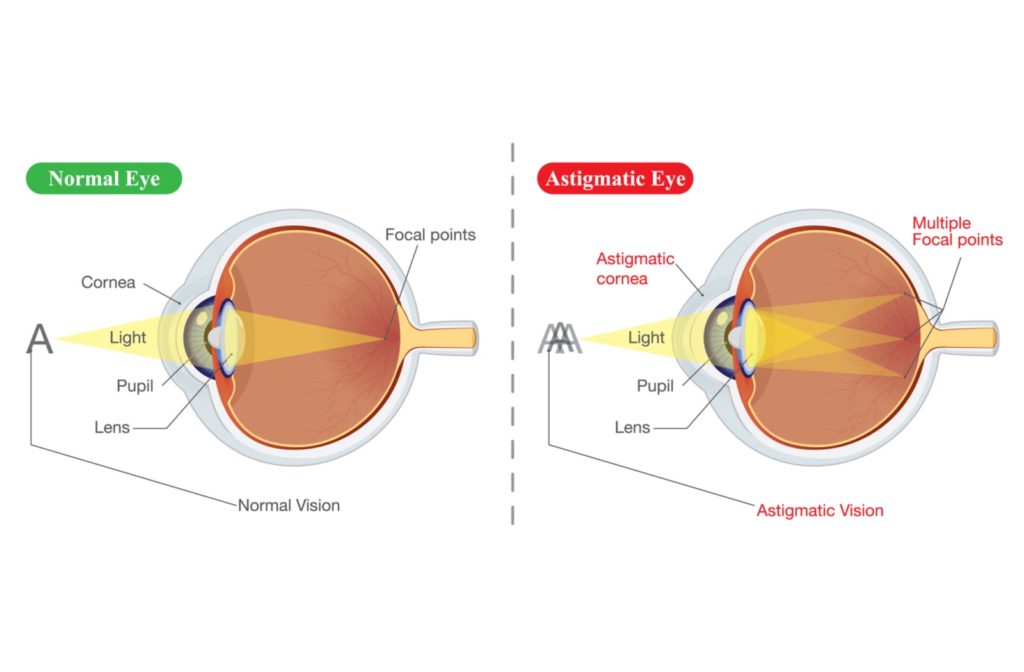Astigmatism is a very common eye condition that can affect the sharpness of your vision. There are a variety of different ways to treat astigmatism and mitigate its effects on your eyesight, such as prescription eyeglasses and laser surgery. One of the most convenient and non-disruptive treatment options is specialty contact lenses for astigmatism.
What Is Astigmatism?
Astigmatism is a refractive error caused by the shape of the cornea or lens of your eye. An irregularly shaped cornea or lens prevents light from focusing properly on the retina, which results in your vision being blurred or distorted. Nearsightedness and farsightedness involve refractive errors which make certain distances blurry or distorted, while the condition of astigmatism involves distortions and blurriness at all distances.
Most people have some form of astigmatism; the effects of astigmatism can be quite subtle or very severe, and treatments or vision aids may need to be used if the condition is severe enough.
Myopic Astigmatism (Nearsightedness)
Myopic astigmatism is when one or both principal meridians of the eye are nearsighted. If both meridians are nearsighted, they are myopic in differing degrees.
Hyperopic Astigmatism (Farsightedness)
Hyperopic astigmatism is when one or both principal meridians are farsighted. If both meridians are farsighted, they are hyperopic in differing degrees.
Mixed Astigmatism
Mixed astigmatism is one eye is nearsighted, and one is farsighted.
Regular and Irregular Astigmatism
Astigmatism can be classified as regular or irregular. Regular astigmatism is when the principal meridians are perpendicular, while irregular is when the meridians are not perpendicular.

What Causes Astigmatism?
Astigmatism is caused by the shape of your cornea or lens being ovular or cylindrical rather than round. Due to the shape of the eye, light will not be focused properly and refractive errors will occur. Astigmatism is manifested through small differences in the growth and alignment of the components of the eye, usually due to genetics.
Keratoconus
Keratoconus is a condition in which the cornea becomes progressively thinner and cone-shaped. Those afflicted with Keratoconus experience astigmatism to a great extent, and eyeglasses will not be sufficient enough to help treat their condition. The best solution for those with keratoconus is achieved with contact lens wear.
Options to Correct Astigmatism
Properly Prescribed & Fitted Eyeglasses
If you are experiencing mild astigmatism, fitted eyeglasses can offer an easy and comfortable solution.
Laser & Other Refractive Surgery
For those who are affected by severe astigmatism, laser or other refractive surgery may be the only way to correct your eyesight.
Orthokeratology (Corneal Refractive Therapy)
Orthokeratology is the process of changing the shape of the cornea or lens without surgery. This kind of therapy uses gas-permeable contact lenses that are worn overnight. The lenses gently and temporarily reshape the front surface of the eye, resulting in clear vision the following day. Orthokeratology is best for those with mild astigmatism.
Contact Lenses
There are many different types of contact lenses that can be used to treat astigmatism and can help correct mild to moderate astigmatism.
Contact Lenses for Astigmatism
Toric
These lenses are made with hydrogel and are similar to regular prescription contact lenses with two main differences:
- Toric lenses have different powers in different meridians of the lens. This helps to correct the varying amount of nearsightedness or farsightedness in different meridians of the eye.
- Toric lenses have a design feature that enables the lens to rotate to the proper orientation on the cornea. This allows the power meridians of the lens to align with the appropriate meridians of the eye for clearer vision.
Gas Permeable
Gas permeable lenses are hard and rigid, and will always keep a spherical shape even if your eye is ovular. A gas permeable lens will replace the misshapen cornea as the primary refracting surface of the eye and help correct astigmatism.
Hybrid
Hybrid lenses involve a mix of properties from gas permeable and toric contact lenses. These lenses have a central zone made of a rigid gas permeable lens material, surrounded by a fitting zone made of a soft hydrogel or silicone hydrogel material. Hybrid lenses offer the best of both toric and gas permeable contact lenses while remaining comfortable for the wearer
Which Kind of Contact Lens is Best for Me?
If you are curious about what type of specialty contact lenses will help you the most with treating your astigmatism, book an eye examination with one of our optometrists to receive a fitting and more information. Astigmatism can affect everyone differently, so it is important to get an examination to narrow down your treatment options.


